In todays rapidly advancing technological landscape, the integration of fall detection with oxygen monitoring is revolutionizing the way we care for our loved ones, particularly the elderly. This innovative approach not only enhances safety but also provides real-time health monitoring, ensuring a comprehensive care solution. As family caregivers, understanding and utilizing these technologies can significantly improve the quality of life for those we care for. In this article, we will explore how these technologies work, their benefits, and how they can be implemented effectively.

Understanding Fall Detection Technology
Fall detection technology is designed to identify when a person has fallen and alert caregivers or medical professionals immediately. This is achieved through sensors that can detect sudden movements or changes in position. These systems are crucial for elderly individuals who are at a higher risk of falls due to health conditions or age-related factors.
How Does Fall Detection Work?
The technology typically uses accelerometers and gyroscopes to monitor a persons movements. When a fall is detected, the system sends an alert to predetermined contacts, ensuring timely assistance. Some advanced systems can even differentiate between a fall and other types of movements, reducing false alarms.
The Role of Oxygen Monitoring
Oxygen monitoring is a critical component in health management, particularly for individuals with respiratory issues or chronic illnesses. It involves tracking the oxygen saturation levels in the blood, providing insights into an individuals respiratory health.
Why is Oxygen Monitoring Important?
Monitoring oxygen levels is vital for detecting health issues early. Low oxygen saturation can indicate respiratory problems, prompting immediate medical intervention. For the elderly, who may have conditions like COPD or heart disease, continuous oxygen monitoring can be lifesaving.
Integrating Fall Detection with Oxygen Monitoring
The integration of these two technologies offers a comprehensive solution for health and safety monitoring. By combining fall detection with oxygen monitoring, caregivers can ensure both the physical safety and respiratory health of their loved ones.
Benefits of Integrated Systems
Integrated systems provide a holistic approach to elderly care. They offer real-time alerts for falls and abnormal oxygen levels, enabling prompt response and reducing the risk of complications. Additionally, these systems can provide data for health monitoring, allowing for better-informed medical decisions.
Implementation in Elderly Care
Implementing these technologies in elderly care requires careful planning and consideration. It is essential to choose systems that are user-friendly and suitable for the specific needs of the individual.
Choosing the Right System
When selecting a system, consider factors such as ease of use, reliability, and the ability to customize alerts. It is also important to ensure that the system can integrate with other health monitoring devices.
Challenges and Considerations
While these technologies offer significant benefits, there are challenges to consider. These include ensuring the privacy of the individual and managing the cost of the technology. It is crucial to weigh the benefits against these challenges to determine the best approach.
Ensuring Privacy
Privacy concerns are a major consideration when implementing these technologies. It is important to choose systems that prioritize data security and allow the individual to control who has access to their information.
The Future of Elderly Care Technology
The future of elderly care technology is promising, with advancements continuing to enhance the quality of care. As technology evolves, we can expect more integrated and user-friendly solutions that further improve safety and health monitoring.
Innovations on the Horizon
Future innovations may include more advanced sensors, improved data analytics, and enhanced connectivity with other smart home devices. These advancements will provide even more comprehensive care solutions.
Conclusion
The integration of fall detection with oxygen monitoring represents a significant advancement in elderly care. By providing real-time alerts and health monitoring, these technologies offer peace of mind for caregivers and improve the quality of life for the elderly. As these technologies continue to evolve, they will play an increasingly important role in ensuring the safety and health of our loved ones.

FAQs
What is the primary benefit of integrating fall detection with oxygen monitoring?
The primary benefit is the comprehensive monitoring of both physical safety and respiratory health, ensuring timely responses to potential health issues.
How can these technologies improve elderly care?
By providing real-time alerts and health data, these technologies allow for prompt medical intervention and informed health decisions, improving overall care quality.
Are there privacy concerns with these systems?
Yes, privacy is a concern. It is important to choose systems that prioritize data security and offer control over information access.
This article contains affiliate links. We may earn a commission at no extra cost to you.






